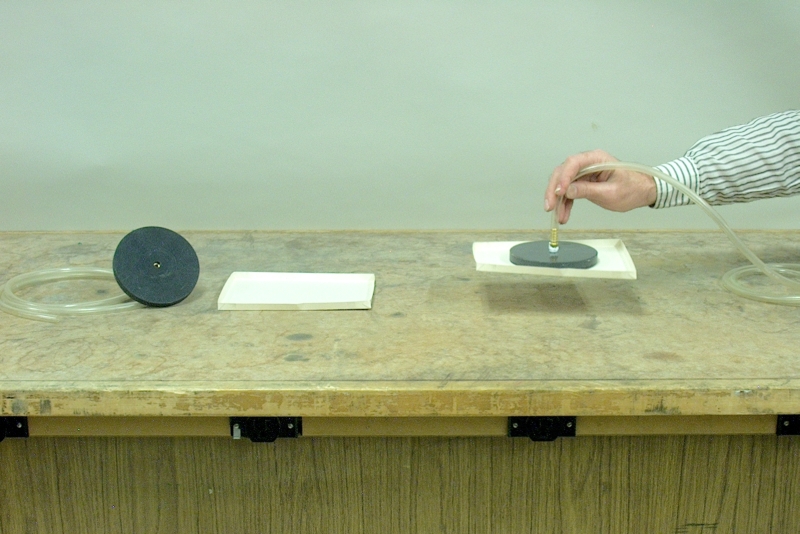

This is a disc with a hole drilled through it in the center. The hole is fitted with a hose barb, to which a length of plastic tubing is attached for connection to a compressed air tap. When you flow air through the hole in the disc, if you then place the disc flat on top of the card (with edges folded upwards to prevent it from sliding sideways off the disc), the card is pressed upwards against the disc, and you can lift it, as shown at right in the photograph above. Before you show this to the class, it is a good idea to demonstrate that air is coming out of the hole in the disc, either by aiming it at the card from a distance and thus blowing the card away, by aiming it at your hair, or by aiming it at something whose movement will make obvious that air is indeed coming out of the hole. Alternatively, you could blow through the tube, but to do this for more than a short time might take considerable effort.
What is happening?
The physics of this situation is described by Bernoulli’s theorem, which describes the steady flow of a nonviscous, incompressible fluid. It states that
p + (1/2)ρv2 + ρgy = constant.
(Some people might be used to seeing this equation stated as (p/ρ) + (1/2)v2 + φ = constant, where φ = gy.) This is strictly true only for flow along a particular streamline of the fluid. If, however, we make the additional simplification that the flow is irrotational, then it applies for flow at any point in the fluid. This equation contains the sum of the static pressure, the pressure that would be present even if there were no flow, which is p + ρgy, and the dynamic pressure, (1/2)ρv2, which arises from the fluid flow. A note on its derivation follows the explanation of the demonstration.
When you bring the disc (with air flowing) close to the card, the air exiting the hole in the disc is forced to flow in the increasingly narrow space between the disc and the card. This gives the air great sideways velocity, which, as the Bernoulli equation tells us, causes the static pressure in the region between the card and the disc to drop (by (1/2)ρv2). Except for the region where the air is flowing from the disc, the card is surrounded by stagnant air at atmospheric pressure. Atmospheric pressure is greater than the lowered static pressure between the disc and the card, and, as the surrounding air pushes up on the card, you can lift it by raising the disc. The upward force on the card is simply (1/2)ρv2 multiplied by the area of the disc (plus perhaps a bit more from air flowing sideways over the overhanging area of the top of the card).
One can arrive at this equation in one of at least two ways. It arises from a formal mathematical treatment of the equations of motion for a fluid, which are similar to those for electrodynamics. Since it is essentially a statement of the conservation of energy, one can also derive it by means of the work-energy theorem. We can envision fluid flowing through a tube with an entrance having a particular cross-sectional area, A1, and an exit at a different height, with an area A2. If we consider a particular volume of fluid at the entrance and at the exit, these correspond to a length l1 at the entrance and l2 at the exit. If we call the entrance pressure p1, the exit pressure p2, and the entrance and exit heights y1 and y2, respectively, we can calculate the total work done on the fluid (by the sum of pressure and gravitational forces) as p1A1l1 - p2A2l2 - mg(y2 - y1). The product of area and length is volume, which we can also write as m/ρ, so this becomes (p1 - p2)(m/ρ) - mg(y2 - y1). By the work-energy theorem, this work must equal the kinetic energy change for the volume element, which we can express as (1/2)mv22 - (1/2)mv12. Equating these gives:
(p1 - p2)(m/ρ) - mg(y2 - y1) = (1/2)mv22 - (1/2)mv12,
which we can rearrange as p1 + (1/2)ρv12 + ρgy1 = p2 + (1/2)ρv22 + ρgy2. Since the subscripts can refer to any two points along the tube, we can drop them and replace the right side of this equation with a constant to give the Bernoulli equation as stated above.
References:
1) Feynman, Richard P., Leighton, Robert B. and Sands, Matthew. The Feynman Lectures on Physics, Volume II, Mainly Electromagnetism and Matter (Reading, Massachusetts: Addison-Wesley Publishing Company, 1963) 40-2 to 40-9.
2) Resnick, Robert and Halliday, David. Physics, Part One, Third Edition (New York: John Wiley and Sons, 1977), pp. 386-391.